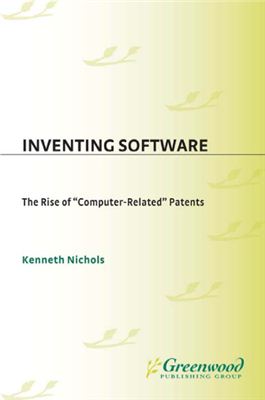Издательство Quorum Books, 1998, -182 pp.
I began this book with the goal of analyzing the ongoing debate within the programming community over the desirability and ultimate effect of software patents. As I delved deeper into the subject, however, I came to the conclusion that the particulars of the debate—which are not that interesting or enlightening—obscure a larger and more important story. Software development is a new kind of creative activity, one that defies the neat and mutually exclusive categorizations of intellectual effort as either artistic or scientific. This defiance is nicely mirrored in the inability of either copyrights or patents to provide an effective and sensible method for protecting innovative activity in software.
As is probably the case with any book that covers a broad range of subjects, this work brings together a number of disparate threads from my own education and experience. Although, as a developer and erstwhile lawyer, I have been interested in the subject of software patents for some time, the idea of investigating the topic in depth was suggested by my friend and former graduate advisor, George Georgiou, whom I must thank for what has been a rewarding experience. Beard Galler of the Software Patent Institute and the University of Michigan generously gave his time and effort to offer many helpful comments and suggestions on the manuscript. Bob Lind, typesetting artist, longtime friend, and Macintosh enthusiast, created the visual design of the book and provided incisive suggestions on the content as well. By far my most valuable ally has been my wife, Aminta O'Connor, who has provided tireless encouragement and wise counsel throughout the process.
Introduction
Algorithms, Inventions, and Software
Software Patent Examples
The Software Patent Controversy
A Proposal for Change: SDKR
Recommendations for Software Developers
What Is Programming?
Crisis of the Patent Paradigm
I began this book with the goal of analyzing the ongoing debate within the programming community over the desirability and ultimate effect of software patents. As I delved deeper into the subject, however, I came to the conclusion that the particulars of the debate—which are not that interesting or enlightening—obscure a larger and more important story. Software development is a new kind of creative activity, one that defies the neat and mutually exclusive categorizations of intellectual effort as either artistic or scientific. This defiance is nicely mirrored in the inability of either copyrights or patents to provide an effective and sensible method for protecting innovative activity in software.
As is probably the case with any book that covers a broad range of subjects, this work brings together a number of disparate threads from my own education and experience. Although, as a developer and erstwhile lawyer, I have been interested in the subject of software patents for some time, the idea of investigating the topic in depth was suggested by my friend and former graduate advisor, George Georgiou, whom I must thank for what has been a rewarding experience. Beard Galler of the Software Patent Institute and the University of Michigan generously gave his time and effort to offer many helpful comments and suggestions on the manuscript. Bob Lind, typesetting artist, longtime friend, and Macintosh enthusiast, created the visual design of the book and provided incisive suggestions on the content as well. By far my most valuable ally has been my wife, Aminta O'Connor, who has provided tireless encouragement and wise counsel throughout the process.
Introduction
Algorithms, Inventions, and Software
Software Patent Examples
The Software Patent Controversy
A Proposal for Change: SDKR
Recommendations for Software Developers
What Is Programming?
Crisis of the Patent Paradigm

